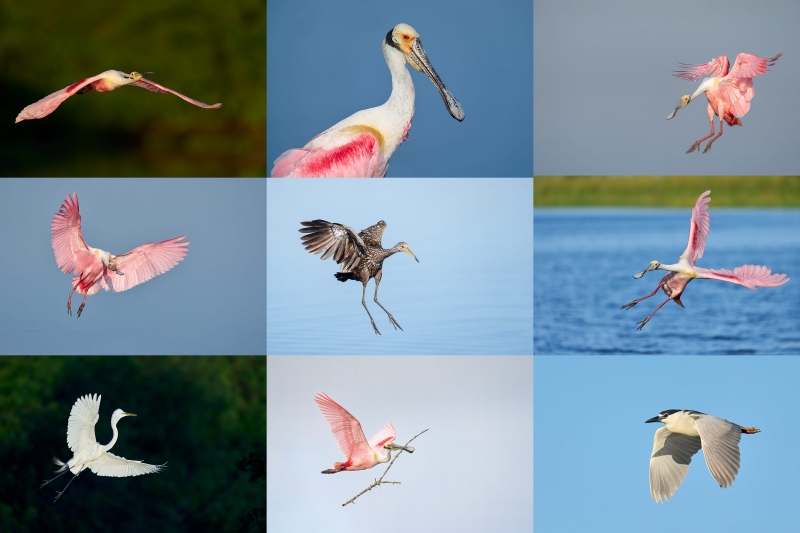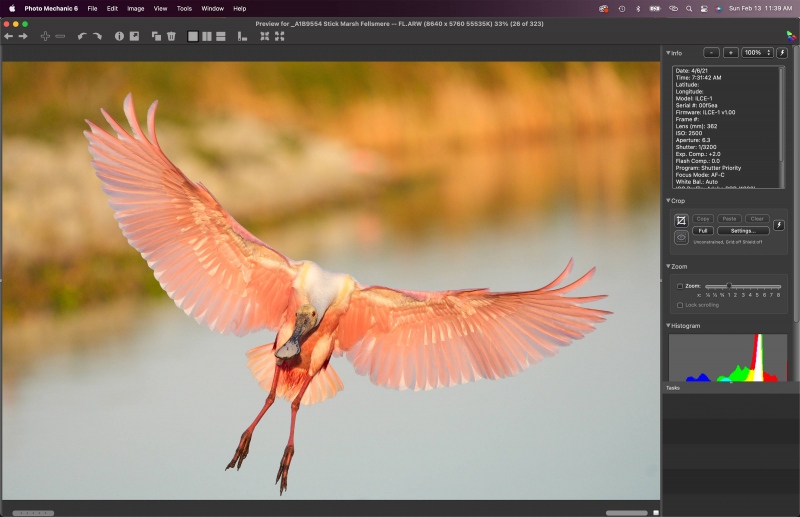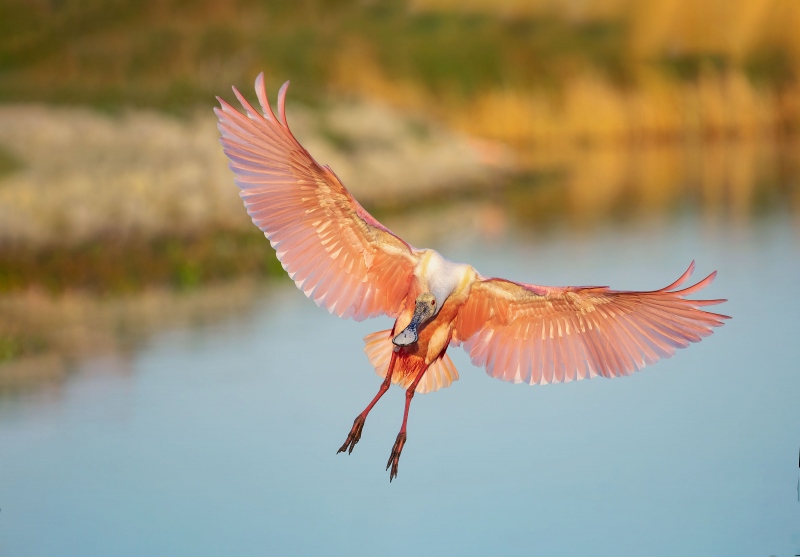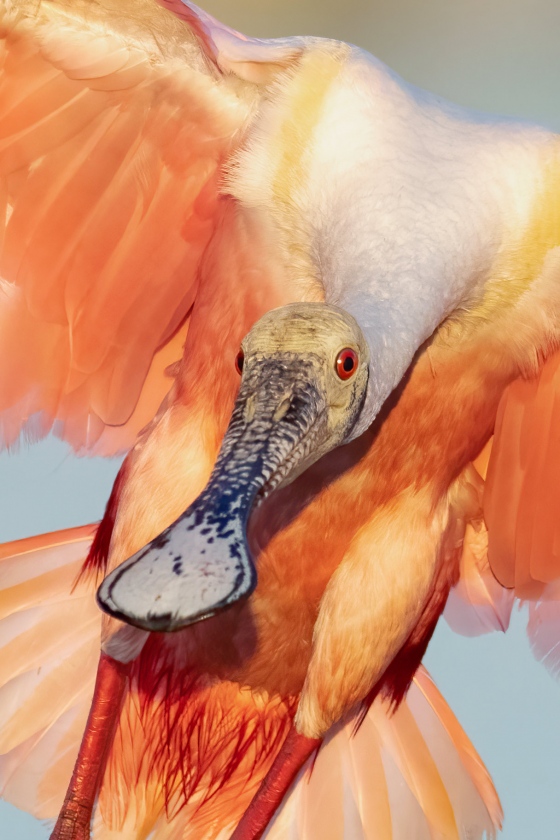How Many Spoonbills? Quiz
How many spoonbills do you see in today’s featured image, Image #1A?
What’s Up?
I forgot to mention that like today’s featured image, both of the Royal Tern images featured in yesterday’s blog post were among the 135,000+ recovered images 🙂
It rained all morning on Sunday and I opted to stay in that afternoon. I got a ton of work done packing for Homer. Today is Monday 14 February. I woke early and watched the second half of the Super Bowl. As I was rooting for the Bengals, I wound up feeling that the commercials were better than the game. I was especially glad for two really classy Ram’s players: game MVP Cooper Kupp (“I do not feel deserving of this award”) and NFL Man of the Year Andrew Whitworth — 16 years to attain his first Super Bowl victory. The Bengals put up a good fight but in the end the Rams star players and their defensive line were too much to overcome. In short, the better team won the game.
The forecast for this morning is a clear and relatively cool 45° with a northwest breeze, a perfect morning to stay in and finished packing! Wherever you are, and whatever you are doing, I hope that you too have a great day. This blog post took about 90 minutes to prepare and makes 92 days in a row with a new one.
Sony Rewards
Via e-Mail from BAA-Friend Dane Johnson
On 30 January I ordered a backup Sony a1 camera body from Bedford’s. The camera purchase was charged to the Sony Visa card. The camera arrived a week ago. After a few days, I went to the Sony Rewards app (rewards.sony.com) and submitted a request (along with a copy of the invoice from Bedford’s) for the 5X bonus points. Today I received an email from Sony Rewards that the bonus points and purchase cred have been approved. For the Sony a1, that worked out to a $284.20 credit applied to my Sony Visa account!. That was a 4.37% discount. If this is combined with the 3% back to your credit card when using the BIRDSASART discount code at Bedfords checkout, the result is a combined savings of about $500 off the price of the a1!
You can sign up for a Sony Rewards credit card here.
Canon 70-200mm f/4L IS USM Lens & Canon 1.4x EF Extender II
Price Reduced $100 on 14 February 2022
BAA-friend Mark Berney is offering a Canon 70-200mm f/4L IS USM lens and a Canon 1.4x EF Extender II (both in excellent condition for) for a silly low $349.00 (was $449.00) via cashiers check only. The sale includes the original product boxes and everything that came in them along with insured ground shipping via major courier to lower-48 US addresses only. Your items will not ship until the check is good to go.
Please contact Mark via e-mail.
The versatile 70-200mm f/4 lenses have long been big favorites of many nature photographers. They are great for landscapes. I owned and used this lens when I shot Canon to create bird-scapes and pre-dawn blast-off blurs at Bosque del Apache NWR in New Mexico. They are relatively fast and sharp and have 1000 uses. The 70-200 f/2.8 lenses are a specialty lens for bird photographers. Like the bad little child, when they are good, they are really, really good! I’ve used mine mostly for flight photography at point blank range where their performance is unmatched, especially in low light. I’ve killed with these lenses on the gannet boat in the UK, in Homer for eagles, for pre-dawn and blizzard blast-offs at Bosque, and at Merritt Island on feeding sprees right next to the road. Lenses in this class are easily hand holdable by just about everyone and do well with the 1.4X TC. artie
ps: To see what the 70-200 zoom lenses can do, see the blog post here.
Via e-mail from Morris Herstein
I never thought that I could make in-flight photos of birds successfully. That goal was accomplished during the recent workshop at Stick Marsh only because I listened to your advice and instructions. For the first time I realized how important sun angle was, teachings that you had been communicated for a long time. The result of two days shooting produced the most satisfying images of Roseate Spoonbills I ever could have imagined.
Stay well and safe. Thank you. Morris
Via e-mail from Joe Usewicz
Wow. So many photos to go through. Stick Marsh was a great learning experience. Positioning. Wind impact. Landing zones. Working on backgrounds. I clipped too many incredible reflections. Great fun. Just amazing opportunities.
Warmest Regards, Joe
|
|
|
Click on the composite image to enjoy the incredible quality of the hi-res JPEG. Clockwise from upper left back around to the center: spoonbill with mangrove background; spoonbill head and shoulders portrait; spoonbill braking to land; spoonbill dramatic landing pose; adult Black-crowned Night-Heron; spoonbill with nesting material; Great Egret returning to nest; incoming spoonbill; and Limpkin landing. |
Stick Marsh IPT: #1: WED 9 March thru the morning of SUN 13 March 2022: $2,299.00. (Limit 6 photographers/Openings: 5)
Stick Marsh IPT #2: MON 14 March thru the morning of FRI 18 March 2022: $2299.00 (Limit 6 photographers)
Do both IPTs back to back and enjoy a $200 discount: protect your travel and time investments against bad weather by signing up for both IPTs for $4398.00.
Stick Marsh, where the living is easy. Photograph incoming Roseate Spoonbills in flight at point blank range with intermediate telephoto zoom lenses. This year I will be trying the new Sony 70-200mm f/2.8 lens, often with the 1.4X TC. Longer lenses either on a tripod or hand held are best for the green background stuff. There will be endless flight photography opportunities with a variety of species; in addition to the spoonbills, we should have some excellent chances on Limpkin, Great Egret, Cattle Egret, Great Blue Heron, Little Blue Heron, Double-created Cormorant, Anhinga, Black and Turkey Vultures, and more. Folks with 500 and 600mm f/4 lenses will have lots of opportunities to hone their skills whether they are working on a tripod or hand holding.
There will be five morning photo sessions averaging four hours. We start in the pre-dawn. The first four morning sessions will be followed by a working brunch. The cost of brunch is included. There will be two after-brunch photo sessions on sunny days (averaging about an hour) to try for bathing spoonbills, usually centered around 1:30pm. There will be one after-brunch photo critique session (probably on DAY 3). And there will be one Image Processing session after brunch.
We will be based in or near Vero Beach. There are AirBnB possibilities for folks who register early. The deposit is $599.00. Call Jim at the office any weekday at 863-692-0906 to pay by credit card. Balances must be paid by check.
What You Will Learn on a Stick Marsh IPT
- 1- You will learn the basics and fine points of digital exposure. Nikon and Canon folks will learn to get the right exposure every time after making a single test exposure, and SONY folks will learn to use Zebras so that they can be sure of making excellent exposures before pressing the shutter button..
- 2- You will learn to work in Manual exposure mode even if you are scared of it.
- 3- You will surely learn to evaluate wind and sky conditions and understand how they affect bird photography.
- 4- You will learn the pro secrets that will help you to become a better flight photographer.
- 5- You will learn to zoom out in advance (because the birds are so close!) 🙂
- 6- You will learn how to approach free and wild birds without disturbing them.
- 7- You will learn to spot the good and the great situations.
- 8- You will learn to understand and predict bird behavior.
- 9- You will learn to design pleasing images by mastering your camera’s AF system.
- 10- You will learn to choose the best perspective.
- 11- You will learn to see and control your backgrounds.
- 12- You will learn to see and understand the light.
- 12- You will learn to see and create pleasing blurs in pre-dawn situations.
- 12- You will learn to be ready for the most likely event at all times.
And the best news is that you will be able to take everything you learn home with you so that you will be a better photographer wherever you are and whenever you photograph.
|
|
|
This image was created on 6 April 2021 at Stick Marsh. I used the hand held Sony FE 200-600mm f/5.6-6.3 G OSS lens (at 362mm), and The One, the Sony Alpha 1 Mirrorless digital camera. ) ISO 2500. Exposure determined via Zebras with ISO on the rear dial: 1/3200 sec. at f/6.3 (wide open) in Manual mode. AWB at 7:32am on a sunny morning. Click on the image to enjoy a high-res version. Image #1: This JPEG represents the original Roseate Spoonbill breaking to land image
|
The Good and the Bad
I had never given this image a second look until yesterday. I generally do not like images with the rock wall in the background. And the bird is much too large in the frame. But the out-of-focus background grew on me. I loved the early morning light. The image is super-sharp on the eye. And best of all, the underwings are perfectly lit with not a single shadow to be seen anywhere. Below, see Image #1A, the optimized version.
|
|
|
This image was created on 6 April 2021 at Stick Marsh. I used the hand held Sony FE 200-600mm f/5.6-6.3 G OSS lens (at 362mm), and The One, the Sony Alpha 1 Mirrorless digital camera. ) ISO 2500. Exposure determined via Zebras with ISO on the rear dial: 1/3200 sec. at f/6.3 (wide open) in Manual mode. AWB at 7:32am on a sunny morning. Tracking: Zone AF/C with Bird Face/Eye detection. Click on the image to enjoy a high-res version. Image #1A: Roseate Spoonbill breaking to land
|
The Optimized Version
I converted the image a bit cooler by reducing the color temperature. With the .TIF file open in Photoshop, I ran Topaz DeNoise as the first step. Then I leveled the image. The most important step was to add canvas on all four sides, especially left and below. I filled in the new canvas in that same step with Content-Aware Fill — make sure to have the boxes for Delete Cropped Pixels and Content-Aware checked before executing the crop. Next, I used the Patch Tool to eliminate a very few repeating patterns. I still was not thrilled with the color so I fiddled around with the YELLOWs a bit in Hue Saturation. Better, but still not what I was after. Then I remembered a neat trick from Digital Basics, the “Average Blur Color Balance Trick.” I remembered how to begin but could not remember all the steps so I opened the Digital Basics II PDF in Preview. It all came back to me and did the job beautifully.
|
|
The BIRDS AS ART Current Workflow e-Guide (Digital Basics II).You can order your copy from the BAA Online Store here, by sending a PayPal for $40 here, or by calling Jim or Jennifer weekdays at 863-692-0906 with your credit card in hand. Be sure to specify Digital Basics II. |
The BIRDS AS ART Current Workflow e-Guide (Digital Basics II)
The techniques mentioned above (including the Average Blur Color Balance trick) and tons more great Photoshop tips and techniques — along with all of my personalized Keyboard Shortcuts — are covered in detail in the BIRDS AS ART Current Workflow e-Guide (Digital Basics II), an instructional PDF that is sent via e-mail. Learn more and check out the free excerpt in the blog post here. While the new e-Guide reflects my MacBook Pro/Photo Mechanic/DPP 4/Photoshop workflow, folks using a PC and/or BreezeBrowser will also benefit greatly by studying the material on DB II. Note: folks working on a PC and/or those who do not want to miss anything Photoshop may wish to purchase the original Digital Basics along with DB II while saving $15 by clicking here to buy the DB Bundle.
Folks who learn well by following along rather than by reading can check out the complete collection of MP 4 Photoshop Tutorial Videos by clicking here. Note: all of the videos are now priced at an amazingly low $5.00 each.
You can learn how and why I converted all of my Canon digital RAW files in DPP 4 in the DPP 4 RAW Conversion Guide here. More recently, I became proficient at converting my Nikon RAW (NEF) files in Adobe Camera Raw. About three years ago I began converting my Nikon and Sony RAW files in Capture One and did that for two years. You can learn more about Capture One in the Capture One Pro 12 Simplified MP4 Video here. The next step would be to get a copy of Arash Hazeghi’s “The Nikon Photographers’ Guide to Phase One Capture One Pro e-Guide” in the blog post here.
You can learn advanced Quick Masking and advanced Layer Masking techniques in APTATS I & II. You can save $15 by purchasing the pair.
|
|
|
Click on the image to enjoy a high-res version. Image #1B: Roseate Spoonbill breaking to land |
Sony Alpha 1 AF
What can I say about a1 autofocus? With today’s featured image, it nailed accurate focus on the eye in a super-difficult situation — a too large in the frame bird flying right at you.
SONY Alpha a1 Set-up and Info Group
The SONY Alpha a1 Set-up and Info Group is going great guns as more and more folks chime in with thoughtful questions and experience-based answers. As the a1 is becoming more readily available, more and more folks are getting their hands on this amazing body. The group is now up to an astounding 109 lucky and blessed folks. Early on, we discussed the myriad AF options. I gave my opinion as to the best one for flight and general bird photography. The best news is that all who wish, can request an e-mail that includes a .DAT file with my a1 settings on it, and explicit directions on how to load my settings onto your a1; talk about convenience! I am now offering a .DAT file compatible with firmware update 1.20. I finally finished the consolidated Sony a1 CAMSETA2 INFO & GUIDE and distributed it yesterday. New a1 folks will now receive three e-mails instead of the previous 28! It is a lot easier on me and is an incredible resource for folks new to the a1.
All who purchased their Alpha a1 bodies via a BAA affiliate link will receive a free subscription to the Sony Alpha a1 Set-Up and Info Updates group after shooting me their receipts via e-mail. (Note: it may take me several days to confirm B&H orders.) This same service may be purchased by anyone with an a1 body via a $150.00 PayPal sent to birdsasart@verizon.net indicating payment for Alpha a1 Info & Updates. Alternatively, folks can call Jim weekdays at 1-863-692-0906 to pay via credit card. New members will receive composite e-mails that summarize all previous discussions.
Typos
With all blog posts, feel free to e-mail or to leave a comment regarding any typos or errors.



















I see one pink blob on the rocks. That plus the subject equals two in total.
with love, artie
5 spoonbills
Thanks. If you are seeing five spoonbills in Image #1A your eyes are way better than mine.
with love, artie
I see “blobs” of pink in the background 🙂
Photos 1 and 1A and 1B are all great and cute Arthur!!!!
Which one is better?
a
Sorry Arthur I was busy later yesterday and couldn’t respond then —– 1A is great!!